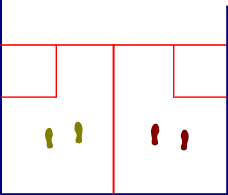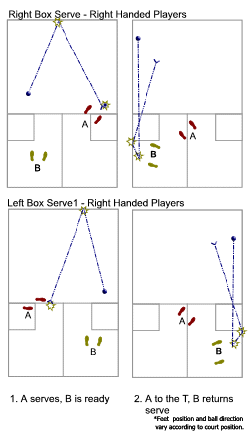The Squash Return of Serve
- The Return of Serve is the first opportunity for the Receiver to move the Server (opponent) away from the centre of the court.
- The Return of Serve feet positioning often determines the type of return possible.
- The first thought when returning the serve should be "can I take this ball on the full (volley)"?
- The second thought "how can I move the Server (opponent) from the T"?
Return of Serve Feet and Body Positioning Positioning with respect to the return of serve can be an individual decision. However, it is important to be able to:
More on Return of Serve & Feet position
| ||||||||||||
Key points on Technique
More on Return of Serve Technique
|
| Good | Bad |
| My return is forcing the opponent away from the T | I get stuck in the back of the court |
| I am able to hit good length with my return | The return is too short |
| The return is tight to the side wall | The opponent steps in volleys my return |
| The opponent is not sure where I am going to hit the ball | Cannot get any variety into my return |
| I have got all return of serves back into play | Keep hitting the tin |
Video clip Return of Serve Alternatives
Return of Serve Alternative Shots
The skill in returning the serve is to be able to recognise which return is the most suitable depending on:
The skill in returning the serve is to be able to recognise which return is the most suitable depending on:
- the height of the serve
- the depth of the serve
- the speed of the serve
- the width of the serve
Video Resources
Video return of serve volley drop off power serve
Volley Drop return of serve off a power serve
A volley drop off a power serve requires:
This shot can be very effective if it drops tightly and softly into the front corner. Strive to get angle into the corner, making it difficult to attack..

A volley drop off a power serve requires:
- a firm wrist
- good racket head control
This shot can be very effective if it drops tightly and softly into the front corner. Strive to get angle into the corner, making it difficult to attack..

Video Resources
Video clip Return of Serve options
Return of Serve incorporating a drive, boast and volley
This video shows attacking returns as well as placement shots played to give time to recover into the court. Note the following clues are being anticipated enabling early preparation for the return:
This video shows attacking returns as well as placement shots played to give time to recover into the court. Note the following clues are being anticipated enabling early preparation for the return:
- The angle of the serve
- The width of the serve
- The height of the serve
Video Resources
Video Return of Serve off Wide Power Serve
Return of Serve off wide power serve
This serve can catch those who do not watch the opponent closely during serving Why?
A good optional return is a drop shot into the corner.
This serve can catch those who do not watch the opponent closely during serving Why?
- As the serve angles to the side wall the ball bounces into the court.
- The angle off the wall can catch the receiver back-pedalling.
A good optional return is a drop shot into the corner.
Video Resources
Video Volley Boast Backhand Return off Power Serve
Volley Boast off Power Serve
This is an excellent shot to get you out of the back corner and ready at the T .The volley boast takes the opponent forward, and provided the boast sits low into the corner, can set up a weaker return.
Always follow up the short shot ready to intercept the return, if it is a length shot, or pick up a short shot in the front of the court.
Tbe volley boast increases the speed of the game, and makes the opponent move forward, and change body position. .
Volley options on Return of Serve
It is very difficult to predetermine what return is best to play in advance, as that decision will depend on a large extent to the type of serve you are returning, eg high or power, wide, deep, etc.
Try to develop a variety of return options to keep the opponent off guard, otherwise the opponent will tend to guess/crowd and be in position almost before you return the ball.
This is an excellent shot to get you out of the back corner and ready at the T .The volley boast takes the opponent forward, and provided the boast sits low into the corner, can set up a weaker return.
Always follow up the short shot ready to intercept the return, if it is a length shot, or pick up a short shot in the front of the court.
Tbe volley boast increases the speed of the game, and makes the opponent move forward, and change body position. .
Volley options on Return of Serve
It is very difficult to predetermine what return is best to play in advance, as that decision will depend on a large extent to the type of serve you are returning, eg high or power, wide, deep, etc.
Try to develop a variety of return options to keep the opponent off guard, otherwise the opponent will tend to guess/crowd and be in position almost before you return the ball.
Video Resources
Video Return of Serve Decision Making
Return of Serve - Where to play the ball
This is an advanced skill and once mastered will take your game to a new level.
Often players become mesmerised or paralysed by the serve, and keep hesitating what to do, eg step in and take it on the volley, wait until it bounces, let it go to the back wall, as well as wonder where to hit it, ie deep, short, cross court, short or long.
Solo pair practice will be helpful to overcome some of this indecision in the future.
Knowing what to do with the serve when it comes will help your confidence when returning serve.
This is an advanced skill and once mastered will take your game to a new level.
Often players become mesmerised or paralysed by the serve, and keep hesitating what to do, eg step in and take it on the volley, wait until it bounces, let it go to the back wall, as well as wonder where to hit it, ie deep, short, cross court, short or long.
Solo pair practice will be helpful to overcome some of this indecision in the future.
Knowing what to do with the serve when it comes will help your confidence when returning serve.
Video Resources
Support Squashgame
Support us here at Squashgame.info! If you think we helped you, please consider our Squash Shop when purchasing or make a small contribution.
